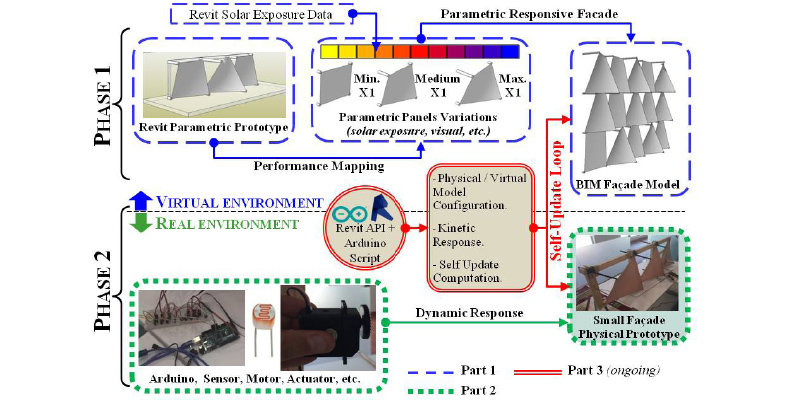Downloads
DOI:
https://doi.org/10.7480/jfde.2018.1.1865Keywords:
Parametric Modeling, BIM, Kinetic Façade, Design Computation, Arduino, Prototypes, ComputationalAbstract
Architectural facades throughout the history have been designed to respond to environmental, social and functional conditions among other considerations. Advancements in Digital Design Computation (DDC) emerged as an essential support for exploring and creating contemporary architectural facades. Current research attempts seeking responsive kinetic facade revealed different methods of integrating kinetics into the physical facade. However, some case studies indicated that physical façades struggled to achieve the anticipated kinetic responses after a facade is constructed. In addition, the process is formal, prescribed, lacks flexibility and can only assist the designer in the visualization of the design. As a consequence, the challenges in understanding the process of connectivity between digital/physical kinetics are important to address in the early design stage. Digital and physical façade prototypes would allow designers to test the qualities of such system before constructing full-size mock-ups and discover new modes of parametric design thinking in architecture.
In this work, we report on an ongoing development of a custom Add-on utilizing Autodesk ® Revit application that connects between the kinetic properties of the digital and physical model to control dynamic façade. We deployed the Revit Application Programming Interface (API) C# programming to manipulate the kinetic response through linear actuation. The system framework proposes a practical mechanism connecting solar exposure values to a Building Information Model (BIM). In this process, an Arduino Mega board, servo motors, tooth-beam and tensile-fabric material were used to construct the small physical prototype and program its automation.
While adding to previous research, we are tackling three challenges. The first is to dynamically harness the response mechanism of kinetic façade so that to avoid uninformed design decision making. The second is to map the digital/physical kinetic properties in terms of: modeling, process and function. The third is to assess the benefits from our approach of connecting BIM parametric model with physical prototypes. Our experimental project demonstrates how data could be transformed digital/physical façade model. We conclude by observations from this work on how BIM parametric modeling with design computation could influence the future direction of kinetic façade systems.
How to Cite
Published
Issue
Section
License
Copyright (c) 2018 Zaki Mallasi

This work is licensed under a Creative Commons Attribution 4.0 International License.
Authors or their institutions retain copyright to their publications without restrictions.
References
BADER, STEFAN (2010). High-performance façades for commercial buildings, Masters Thesis, Master of Science in Sustainable Design, The University of Texas at Austin - School of Architecture.
FRAZER, JOHN. (1995). An Evolutionary Architecture, the Architectural Association, London, UK, E.G. Bond Ltd.
HARFMANN, ANTON C. (2012), ‘Linking Detailed Solar Collection Data to a Parametric Model for Accurate Performance Analysis Throughout the Design Process’, International Journal of Architecture, Engineering and Construction, Vol. 1, No. 1, March 2012, pp. 37-46.
KENSEK, , K. M., (2014). Integration of Environmental Sensors with BIM: case studies using Arduino, Dynamo, and the Revit API. Informes de la Construcción, Vol.66, Octobr-December Issue, page 536-545.
KOLAREVIC, BRANKO (2014). Exploring Architecture of Change. 7th ASCAAD International Conference. Digital Crafting - Virtualizing Architecture and Delivering Real Built Environment, Effat University, Jeddah, Saudi Arabia, pp 15-26.
LOONEN, R. C. G. M., TRČKA, M., CÓSTOLA, D., and HENSEN, J. L. M. (2013). Climate adaptive building shells: state-of-the-art and future challenges. Renewable and Sustainable Energy Reviews, 25, pp. 483-493.
LINN, C. (2014). Kinetic Architecture: Design for Active Envelopes. Images Publishing.
MASSEY, J. (2006). Buckminster Fuller's cybernetic pastoral: the United States Pavilion at Expo 67. The Journal of Architecture, 11(4), pp. 463-483.
PARK, KAT, and HOLT, NICHOLAS. (2010), ‘Parametric Design Process of a Complex Building In Practice Using Programmed Code As Master Model’, International Journal of Architectural Computing, Issue (3), Vol. 8, September 2010, pp. 359-376.
SHARAIDIN, M.KAMIL and SALIM, FLORA (2011). Affordable, Performative and Responsive: Designing affordable responsive architectural prototypes through physical and digital modeling, Proceedings of the 16th International Conference on Computer-Aided Architectural Design Research in Asia (CAADRIA), Hong Kong, pp. 113–122.
SHARAIDIN, KAMAL (2014). Kinetic Facades: Towards design for Environmental Performance, PhD Thesis, Spatial Information Architecture Laboratory (SIAL), School of Architecture and Design, RMIT University, Available from [https://researchbank.rmit.edu.au/eserv/rmit:161145/Sharaidin.pdf], [Last Visited: 27, June, 2016].
TASHAKORI, MAHZAD (2014). Design of a Computer Controlled Sun-Tracking Facade Model, Masters Thesis, The Pennsylvania State University, College of Arts and Architecture, Available from [https://etda.libraries.psu.edu/paper/21370/22437], [Last Visited: 27, October, 2015].
